- ball of clay
- clay canoe (both made from same amount of clay)
- recycled food trays and containers
- plastic plates
- paper clips
- craft sticks
- sponges
- aluminum foil
- pennies
- sticky notes
- marker
- chart paper
- paper towels (for spills)
- camera or cellphone with camera
- large plastic containers of water
- boat
- float
- sink
MA Standards:
Speaking and Listening/SL.PK.MA.5: Create representations of experiences or stories (e.g., drawings, constructions with blocks or other materials, clay models) and explain them to others.
Language/L.PK.MA.6: Use words and phrases acquired through conversations, listening to books read aloud, activities, and play.
Mathematics/Measurement and Data/PK.MD.MA.2: Compare the attributes of length and weight for two objects, including longer/shorter, same length; heavier/lighter, same weight; holds more/less, holds the same amount.
Head Start Outcomes:
Logic and Reasoning/Reasoning and Problem Solving: Classifies, compares, and contrasts objects, events, and experiences.
Science Knowledge/Scientific Skills and Method: Observes and discusses common properties, differences, and comparisons among objects.
PreK Learning Guidelines:
English Language Arts/Language 2: Participate actively in discussions, listen to the ideas of others, and ask and answer relevant questions.
Science and Technology/Physical Sciences 19: Explore, describe, and compare the properties of liquids and solids found in children's daily environment.
Explore Together (indoors): Boats Afloat

© Commonwealth of Massachusetts, Department of Early Education and Care (Jennifer Waddell photographer). All rights reserved.
STEM Key Concepts: Objects behave differently in water; Some things float; Some things sink; If you add enough weight to a floating object, it will sometimes sink; Solids have physical characteristics that can be observed and described
ELA Focus Skills: Cause and Effect, Compare and Contrast, Follow Directions, Listening and Speaking, Predicting, Vocabulary
Educator Prep: Before the activity, make a small flat-bottomed aluminum foil boat with upturned sides. Fold up sides to form a kind of box-hull and pinch the front slightly to shape a bow.
Safety Tips:
- Be sure to clean and disinfect the water table and the plastic containers daily and fill the table with fresh water each day.
- Be sure to have plenty of towels and/or a mop handy for clean-up of spills.
Tell children they are going to use the materials to make boats and explore floating and sinking them. Hold up the ball of clay and the clay canoe. Tell children each object is made from the same amount of clay. Ask, Which shape do you think will make the most successful floating boat? Why do you think so? After observing, talk about how the shape of an object can determine whether it will float or sink.
Tell children they are going to explore using the materials to make a boat that will hold the biggest load and still float on the water. Guide children to use food trays and plastic plates for boats or to make an aluminum foil boat that will float. Display your aluminum foil boat for reference.
As children explore, encourage them to explore making their boats stay afloat as they fill them with objects. Listen to and engage children when they observe. Ask questions such as,
- Do you think the boat will most likely float if you fill it with craft sticks or pennies? Why do you think that?
- Why do you think the food container can stay afloat holding more pennies than the aluminum foil boat?
- What do you think will happen if you put a wet sponge in the aluminum foil boat?
Reflect and Share
Gather children and have them bring their boats so they can share their observations. Ask children questions such as,
- Why do you think you needed a different number of pennies to sink the container boat and the aluminum foil boat?
- How did you use the sponge pieces to keep your boat floating on the water? What did you do that made the boat sink?
- What other materials would you like to try when exploring floating and sinking next time?
Adaptation: You might prefer to have very young children do the activity individually, with one-to-one supervision.
Adaptation: If the weather is warm, you may want to bring the materials outside. You can fill the containers outside, or fill a plastic pool with water. Then do the activity without worrying about spills.
